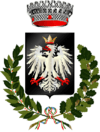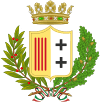Pazzano
| Pazzano | ||
|---|---|---|
| Comune | ||
| Comune di Pazzano | ||
 Panorama of Pazzano | ||
| ||
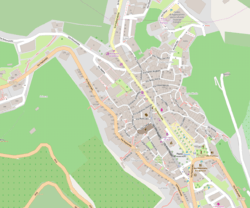 Pazzano, urban area | ||
 Pazzano Location of Pazzano in Italy | ||
| Coordinates: 38°29′N 16°27′E / 38.483°N 16.450°E | ||
| Country | Italy | |
| Region | Calabria | |
| Metropolitan city | Reggio Calabria (RC) | |
| Government | ||
| • Mayor | Salvatore Fiorenza (since April 5, 2005) | |
| Area | ||
| • Total | 15 km2 (6 sq mi) | |
| Elevation | 460 m (1,510 ft) | |
| Population [1] | ||
| • Total | 799 | |
| • Density | 53/km2 (140/sq mi) | |
| Demonym(s) | Pazzanesi | |
| Time zone | UTC+1 (CET) | |
| • Summer (DST) | UTC+2 (CEST) | |
| Postal code | 89040 | |
| Dialing code | 0964 | |
| Patron saint | St. Joseph | |
| Saint day | March 19 | |
| Website | Official website | |
Pazzano (Calabrian: Pazzanu) is a village and comune located in Locride's region in the province of Reggio Calabria (Calabria, southern Italy).
History
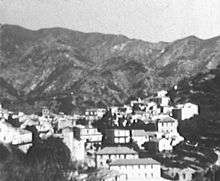
The first known mention of Pazzano dates to a 1094 document. The town was founded as a minerary center for the exploitation of iron (by pyrite and limonite) and molybdenum (the latter in caves of Monte Stella and Monte Consolino) deposits. During the period of the Kingdom of the Two Sicilies, its 25 mines made Pazzano the most important mining centre in all of southern Italy. The minerals were processed at Reali ferriere ed Officine di Mongiana in Mongiana.
Pazzano became a comune in 1811. Minerary activities lasted until the 20th century. During the 1950s, the inhabitants began to emigrate to northern Italy, and Pazzano's population drastically reduced.
At Sydney,(Australia), since the 1950s the emigrants of Pazzano created a little Community in Brookvale (nicknamed Pazzaniedu) and at Narraweena, every year take place the Santo Salvatore's fiest.
There is also a little community at Aliquippa in Pennsylvania (USA).
By the 1980s the ecomuseum Ecomuseo delle ferriere e fonderie di Calabria (Ecomuseum of iron-foundry and foundry of Calabria) was to preserve and remember the industrial archaeology of the town.
Main sights
- Chiesa di Santa Maria Assunta in Cielo (Santa Maria's church)
- Santuario di Monte Stella (Monte Stella's Sanctuary)
- The 25 old iron mines of Borbonic period, now closed:
- Principe Ereditario (Settecento)
- Carolina (Settecento)
- S. Ferdinando (Settecento)
- Regina
- Noceto
- Scolo
- Galleria Italia
- Galleria Piave
- Galleria Acqua Calda
- Contrì
- San Giuseppe
- R. Principe
- Colle di Banno
- Lucarello
- S. Maria
- Perrone
- Gotto
- perronello
- Clementina
- Clementina II
- San Carlo
- San Nicola
- Campoli
- Garibaldi
- San Luigi
- Grotta Nuova
- Provvisoria
- Regina ribasso
- Melichicchi
- Umberto I
- Fontana Vecchia or Fontana dei minatori (Old Fountain or Miner's Fountain)
Notable people
- Giuseppe Coniglio (December 2, 1922 – March 13, 2006), poet. He wrote Calabria contadina (poetry, 1973), Quattru chjacchjari e ddui arrisi (poetry, 1984), A terra mia (poetry, 1998) and Marcu e Filomena (theatrical comedy)
- Luigi Sbarra, CISL syndicalist, CISL secretary of Calabria since 1960 up to 2000, since December 16, 2009 he is member of CISL national secretariat. In 2006 received 'Mediterraneo - Impegno e civiltà award.
- Roberto Taverniti (February 18, 1888 – September 16, 1916), journalist of Il Divenire sociale and founder of Terra Nostra newspaper. He died in first world war.
- Sandro Taverniti (June 29, 1944), writer and poet. He wrote Quando Maria Cantava, Dissestate Rime (2007) and Nel paese dei due Re (2010).
- Giuseppe Fiorenza, writer, screenwriter and director, founder of the Barlaam center (a cultural association about calabrian narratives), he wrote Fuori dalla gente (1980), La terra senza Dio (1995), Io t'ho amato sempre non t'ho amato mai (2007), Un viaggio lungo 35 anni 11 mesi 29 giorni (2010) and Il paese del malocchio (2011), as director: Storie di Palazzo, C'era una volta un baracchino Fiat, Festa. In the 1985 collaborated in the Daniele Segre movie: Andata e ritorno.
Economy


In the past Pazzano had an industrial activity related with Reali Ferriere di Mongiana, people who worked in the field in spring and summer period on winter worked in the iron mines. The subsistence agriculture produced olive oil, wine, grain, cheese, vegetables like eggplants, tomatoes, chicory, zucchini, beans, chickpeas, fruit like oranges, figs, and pears. There were also limestone quarries, hydraulic mills, and a homemade of dress production. The SS110 road has been paved for the first time in the 1950s by pazzano's entrepreneurs from Monasterace Marina to Serra San Bruno.
From the 1957 up to 1975 Pazzano was the headquarters of transport truck company Sabatino Salvatore & figli (after moving from Stilo). In the 1960s there were more than 60 commercial activities among hairdressers, tailors, shoemakers, bar owners, drugstores... The 1960s was also the period when started southern emigration to Italian northern cities and year by year all the activities were closed.
Today
The economy of Pazzano now is largely based on agriculture: olive oil production, fruit harvesting, and religious tourism. Recently, there have been some attempts in Vallata dello Stilaro and Serre calabresi to increase natural tourism with the creation of the near Parco naturale regionale delle Serre (Serre's park) and archaeological industrial tourism with the ecomuseum creation of Ecomuseo delle ferriere e fonderie di Calabria and the building of Museo della cultura mineraria (mine culture museum) in Pazzano.
Transportation
Pazzano is located on the SS 110 state road, 15 kilometres (9 mi) from the coastal town of Monasterace Marina.
There is a bus service, Federico, that links Pazzano with Reggio Calabria and several other towns including Stilo, Caulonia, Gioiosa Ionica and Locri. The nearest railway station is Monasterace Marina (15 km).
Administration
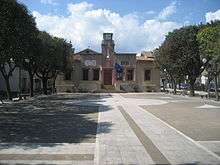
Italian republic period
| Sindaco (Mayor) | Party | Election day |
|---|---|---|
| Francesco Fiorenza | 1943 | |
| Emilio Amato | 1944 | |
| Rocco Micelotta | 1946 | |
| Remo Taverniti | 1954 | |
| Libero Taverniti | 1961 | |
| Ilario Papello | 1965 | |
| Francesco Russo | 1969 | |
| Stefano Zannino | 1971 | |
| Francesco Zannino | 1973 | |
| Francesco Zannino | 1978 | |
| Salvatore Fiorenza | 1984 | |
| Salvatore Tassone | 1986 | |
| Salvatore Tassone | 1990 | |
| Salvatore Zannino | Lista civica | 1996 |
| Salvatore Zannino | Lista civica | 05/04/2000 |
| Salvatore Fiorenza | Lista civica | 05/04/2005 |
| Franco Depace | Lista civica | 29/03/2010 |
| Alessandro Taverniti | Lista civica | 31/05/2015 |
Feast-days
- March 19 - Feast of San Giuseppe & procession. "ciciri e cannarozza"
- May 1 - Feast of Madonna Immacolata
- 1st Sunday of August - SS. Salvatore's feast
- 14–15 August - Pilgrimage to Madonna della Stella's sanctuary cave
- 3–5 September - San Rocco's feast
- October 31 - Mbeati muorti's feast
Food
Pazzano's food is typical of Calabria, and includes:
See also
References
External links
| Wikimedia Commons has media related to Pazzano. |
- New site of Comune di Pazzano (2006)
- Circolo ricreativo culturale giovanile pazzanese
- Pazzano's history (italian site)
- Comunità montana Stilaro Allaro
- Dialetto - 'u tripu da cona' on YouTube
- Cunfrunti1 (Feast of Saint Salvatore)on YouTube
- Cunfrunti2 (Feast of Saint Salvatore)on YouTube
- Pazzanese proverb - YouTube
